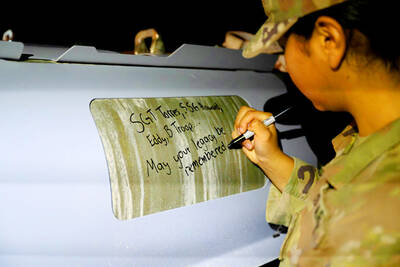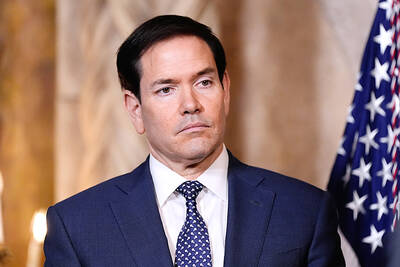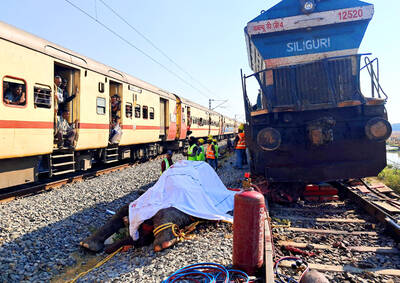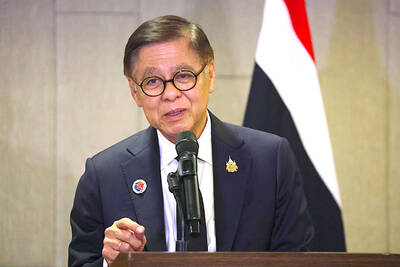China appears to be building a large laser-ignited fusion research center in the southwestern city of Mianyang, experts at two analytical organizations said, a development that could aid nuclear weapons design and work exploring power generation.
Satellite photos show four outlying “arms” that would house laser bays, and a central experiment bay that would hold a target chamber containing hydrogen isotopes the powerful lasers would fuse together, producing energy, said Decker Eveleth, a researcher at US-based independent research organization CNA Corp.
It is a similar layout to the US$3.5 billion US National Ignition Facility (NIF) in northern California, which in 2022 generated more energy from a fusion reaction than the lasers pumped into the target — “scientific breakeven.”
Eveleth, who is working with analysts at the James Martin Center for Nonproliferation Studies, estimates the experiment bay at the Chinese facility is about 50 percent bigger than the one at NIF, the world’s largest.
The development has not been previously reported.
“Any country with an NIF-type facility can and probably will be increasing their confidence and improving existing weapons designs, and facilitating the design of future bomb designs without testing” the weapons themselves, said William Alberque, a nuclear policy analyst at the Henry L. Stimson Center.
The Chinese Ministry of Foreign Affairs referred Reuters questions to the “competent authority.” The Chinese Ministry of Science and Technology did not respond to a request for comment.
The US Office of the Director of National Intelligence declined to comment.
In November 2020, US arms control envoy Marshall Billingslea released satellite images which he said showed China’s buildup of nuclear weapons support facilities. It included images of Mianyang showing a cleared plot of land labeled “new research or production areas since 2010.”
That plot is the site of the fusion research center, called the Laser Fusion Major Device Laboratory, according to construction documents that Eveleth shared with Reuters.
Igniting fusion fuel allows researchers to study how such reactions work and how they might one day create a clean power source using the universe’s most plentiful resource, hydrogen. It also enables them to examine nuances of detonation that would otherwise require an explosive test.
The Comprehensive Nuclear Test Ban Treaty, of which China and the US are signatories, bans nuclear explosions in all environments.
Countries are allowed “subcritical” explosive tests, which do not create nuclear reactions. Laser fusion research, known as inertial confinement fusion, is also allowed.
Siegfried Hecker, a senior fellow at the Freeman Spogli Institute for International Studies and former director of Los Alamos National Laboratory, another key US nuclear weapons research facility, said that with testing banned, subcritical and laser fusion experiments were crucial to maintaining the safety and reliability of the US nuclear arsenal.
But for countries that have not done many test detonations —China has tested 45 nuclear weapons, compared with 1,054 for the US States — such experiments would be less valuable because they do not have a large data set as a base, he said.
“I don’t think it would make an enormous difference,” Hecker said. “And so ... I’m not concerned about China getting ahead of us in terms of their nuclear facilities.”
Other nuclear powers, such as France, the UK and Russia, also operate inertial confinement fusion facilities.
The size of those facilities reflects the amount of power designers estimate is needed to apply to the target to achieve ignition, said Omar Hurricane, chief scientist for the inertial confinement fusion programme at Lawrence Livermore National Laboratory, which operates NIF.
“These days, I think you probably can build a facility that’s of equal energy or even more energetic [than NIF] and a smaller footprint,” Hurricane said.
However, he added that at too small a scale, experimental fusion does not appear possible.
That other countries operate laser-driven fusion research centers is not a cause for alarm in itself, Hurricane said.
“It’s kind of hard to stop scientific progress and hold information back,” he said. “People can use science for different means and different ends, and that’s a complicated question.”

REVENGE: Trump said he had the support of the Syrian government for the strikes, which took place in response to an Islamic State attack on US soldiers last week The US launched large-scale airstrikes on more than 70 targets across Syria, the Pentagon said on Friday, fulfilling US President Donald Trump’s vow to strike back after the killing of two US soldiers. “This is not the beginning of a war — it is a declaration of vengeance,” US Secretary of Defense Pete Hegseth wrote on social media. “Today, we hunted and we killed our enemies. Lots of them. And we will continue.” The US Central Command said that fighter jets, attack helicopters and artillery targeted ISIS infrastructure and weapon sites. “All terrorists who are evil enough to attack Americans are hereby warned

‘POLITICAL LOYALTY’: The move breaks with decades of precedent among US administrations, which have tended to leave career ambassadors in their posts US President Donald Trump’s administration has ordered dozens of US ambassadors to step down, people familiar with the matter said, a precedent-breaking recall that would leave embassies abroad without US Senate-confirmed leadership. The envoys, career diplomats who were almost all named to their jobs under former US president Joe Biden, were told over the phone in the past few days they needed to depart in the next few weeks, the people said. They would not be fired, but finding new roles would be a challenge given that many are far along in their careers and opportunities for senior diplomats can

Seven wild Asiatic elephants were killed and a calf was injured when a high-speed passenger train collided with a herd crossing the tracks in India’s northeastern state of Assam early yesterday, local authorities said. The train driver spotted the herd of about 100 elephants and used the emergency brakes, but the train still hit some of the animals, Indian Railways spokesman Kapinjal Kishore Sharma told reporters. Five train coaches and the engine derailed following the impact, but there were no human casualties, Sharma said. Veterinarians carried out autopsies on the dead elephants, which were to be buried later in the day. The accident site

RUSHED: The US pushed for the October deal to be ready for a ceremony with Trump, but sometimes it takes time to create an agreement that can hold, a Thai official said Defense officials from Thailand and Cambodia are to meet tomorrow to discuss the possibility of resuming a ceasefire between the two countries, Thailand’s top diplomat said yesterday, as border fighting entered a third week. A ceasefire agreement in October was rushed to ensure it could be witnessed by US President Donald Trump and lacked sufficient details to ensure the deal to end the armed conflict would hold, Thai Minister of Foreign Affairs Sihasak Phuangketkeow said after an ASEAN foreign ministers’ meeting in Kuala Lumpur. The two countries agreed to hold talks using their General Border Committee, an established bilateral mechanism, with Thailand